Science and Technology: Enhancing Early Childhood Education
VerifiedAdded on 2023/06/07
|10
|2817
|365
Report
AI Summary
This report explores the integration of science and technology into early childhood education, focusing on the development of essential skills and understanding in children aged 0 to 5. It highlights the importance of incorporating science and technology into the Australian curriculum and the Early Years Learning Framework (EYLF) to promote scientific thinking and enhance learning capabilities. The report delves into two key areas—biological and chemical sciences—providing practical examples of how these can be applied in early years settings to foster curiosity and engagement. It emphasizes the need for hands-on activities that encourage exploration, observation, and problem-solving, ultimately recommending the provision of professional development and additional resources for educators to maximize the impact of science and technology education in early childhood.
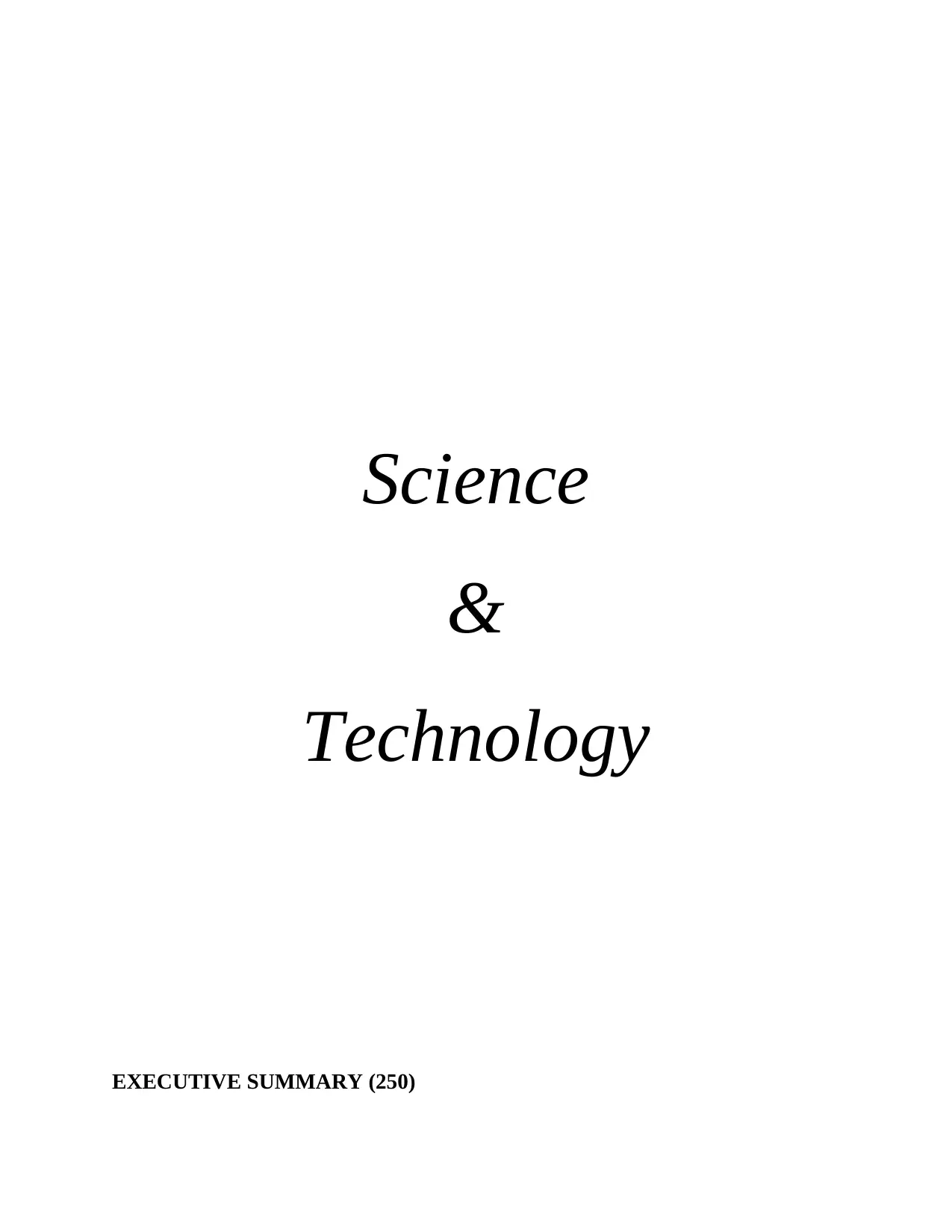
Science
&
Technology
EXECUTIVE SUMMARY (250)
&
Technology
EXECUTIVE SUMMARY (250)
Paraphrase This Document
Need a fresh take? Get an instant paraphrase of this document with our AI Paraphraser
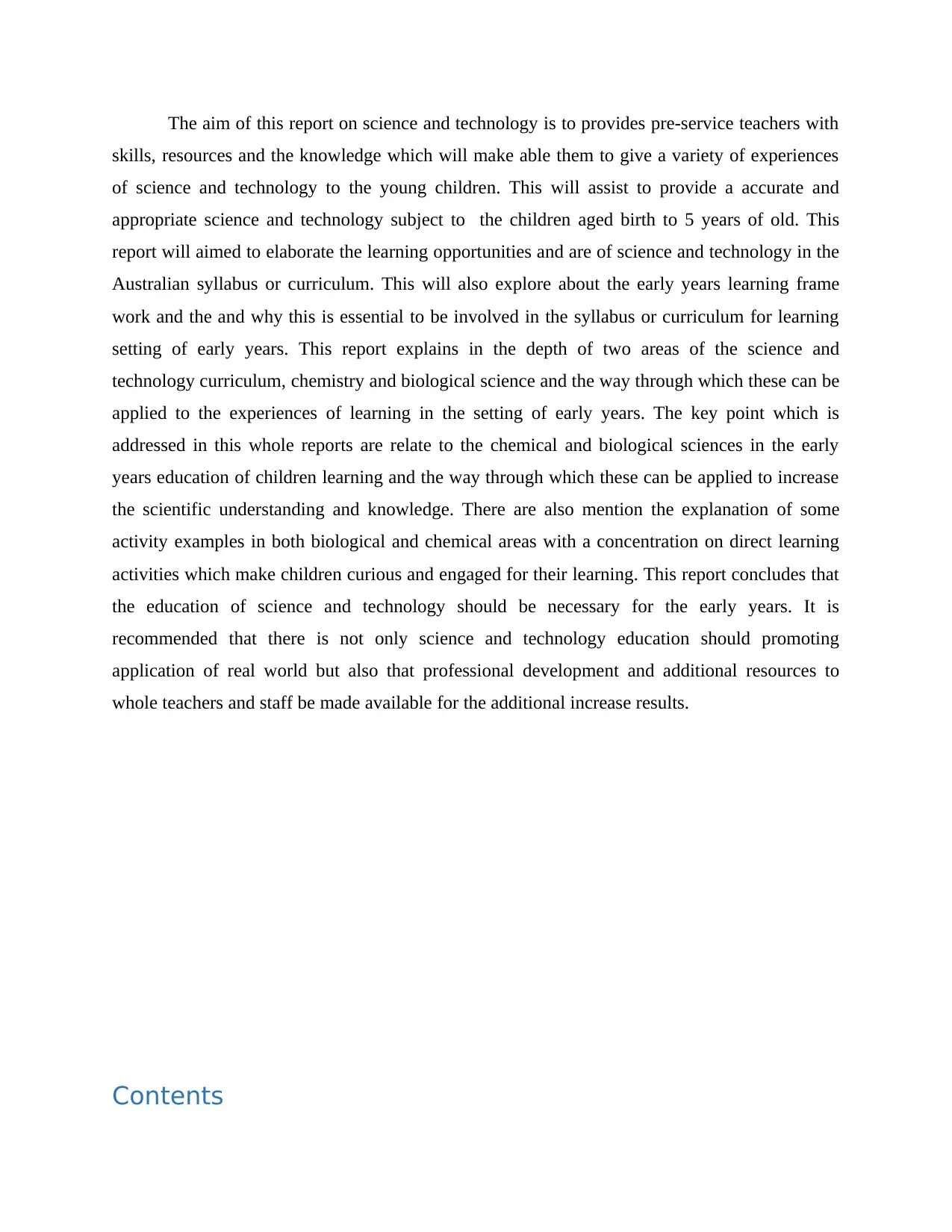
The aim of this report on science and technology is to provides pre-service teachers with
skills, resources and the knowledge which will make able them to give a variety of experiences
of science and technology to the young children. This will assist to provide a accurate and
appropriate science and technology subject to the children aged birth to 5 years of old. This
report will aimed to elaborate the learning opportunities and are of science and technology in the
Australian syllabus or curriculum. This will also explore about the early years learning frame
work and the and why this is essential to be involved in the syllabus or curriculum for learning
setting of early years. This report explains in the depth of two areas of the science and
technology curriculum, chemistry and biological science and the way through which these can be
applied to the experiences of learning in the setting of early years. The key point which is
addressed in this whole reports are relate to the chemical and biological sciences in the early
years education of children learning and the way through which these can be applied to increase
the scientific understanding and knowledge. There are also mention the explanation of some
activity examples in both biological and chemical areas with a concentration on direct learning
activities which make children curious and engaged for their learning. This report concludes that
the education of science and technology should be necessary for the early years. It is
recommended that there is not only science and technology education should promoting
application of real world but also that professional development and additional resources to
whole teachers and staff be made available for the additional increase results.
Contents
skills, resources and the knowledge which will make able them to give a variety of experiences
of science and technology to the young children. This will assist to provide a accurate and
appropriate science and technology subject to the children aged birth to 5 years of old. This
report will aimed to elaborate the learning opportunities and are of science and technology in the
Australian syllabus or curriculum. This will also explore about the early years learning frame
work and the and why this is essential to be involved in the syllabus or curriculum for learning
setting of early years. This report explains in the depth of two areas of the science and
technology curriculum, chemistry and biological science and the way through which these can be
applied to the experiences of learning in the setting of early years. The key point which is
addressed in this whole reports are relate to the chemical and biological sciences in the early
years education of children learning and the way through which these can be applied to increase
the scientific understanding and knowledge. There are also mention the explanation of some
activity examples in both biological and chemical areas with a concentration on direct learning
activities which make children curious and engaged for their learning. This report concludes that
the education of science and technology should be necessary for the early years. It is
recommended that there is not only science and technology education should promoting
application of real world but also that professional development and additional resources to
whole teachers and staff be made available for the additional increase results.
Contents

EXECUTIVE SUMMARY (250)....................................................................................................2
INTRODUCTION (250)..................................................................................................................1
MAIN BODY (1250).......................................................................................................................1
Key points:...................................................................................................................................1
Biology:........................................................................................................................................3
Chemistry:....................................................................................................................................4
CONCLUSION AND RECOMMENDATION...............................................................................4
REFERENCES................................................................................................................................5
INTRODUCTION (250)..................................................................................................................1
MAIN BODY (1250).......................................................................................................................1
Key points:...................................................................................................................................1
Biology:........................................................................................................................................3
Chemistry:....................................................................................................................................4
CONCLUSION AND RECOMMENDATION...............................................................................4
REFERENCES................................................................................................................................5
⊘ This is a preview!⊘
Do you want full access?
Subscribe today to unlock all pages.

Trusted by 1+ million students worldwide
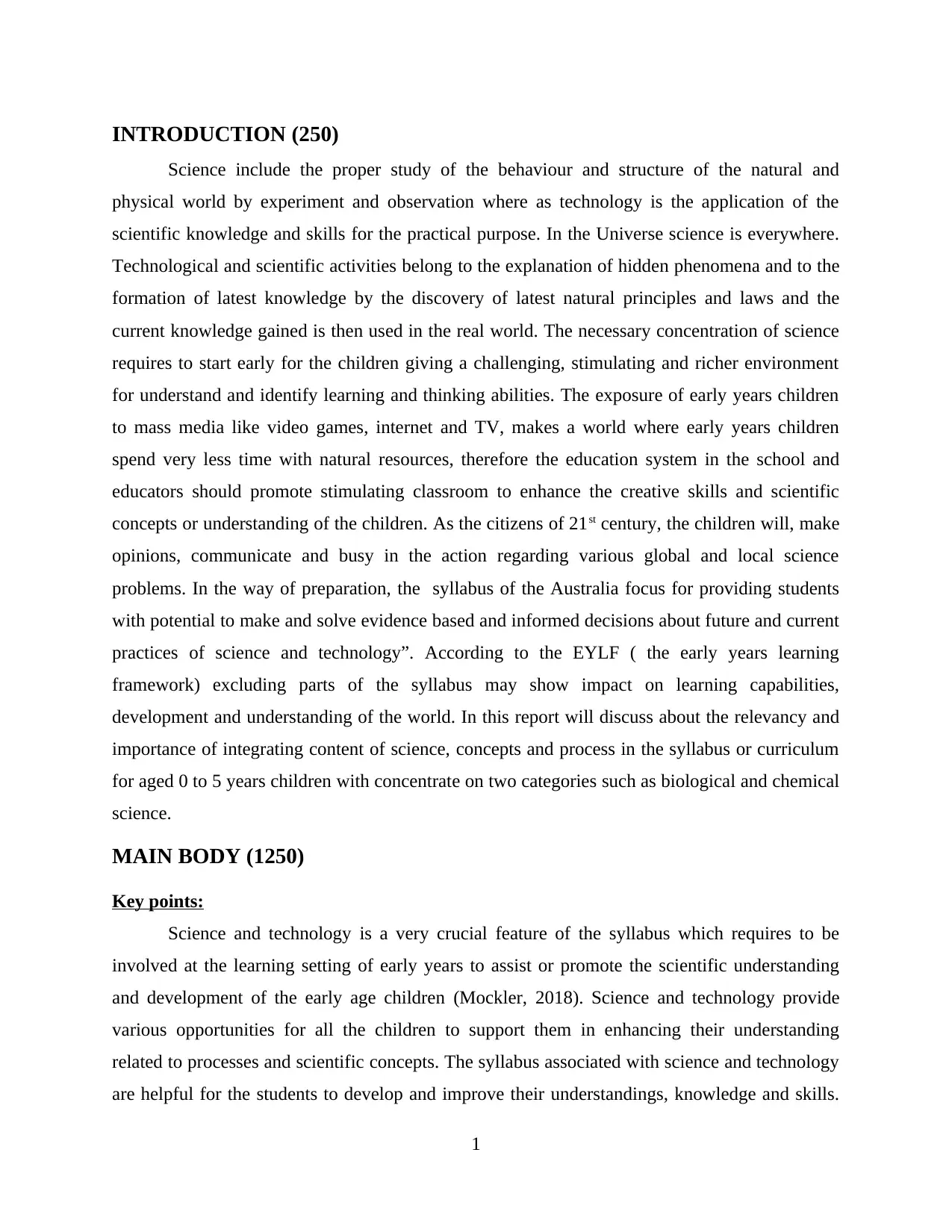
INTRODUCTION (250)
Science include the proper study of the behaviour and structure of the natural and
physical world by experiment and observation where as technology is the application of the
scientific knowledge and skills for the practical purpose. In the Universe science is everywhere.
Technological and scientific activities belong to the explanation of hidden phenomena and to the
formation of latest knowledge by the discovery of latest natural principles and laws and the
current knowledge gained is then used in the real world. The necessary concentration of science
requires to start early for the children giving a challenging, stimulating and richer environment
for understand and identify learning and thinking abilities. The exposure of early years children
to mass media like video games, internet and TV, makes a world where early years children
spend very less time with natural resources, therefore the education system in the school and
educators should promote stimulating classroom to enhance the creative skills and scientific
concepts or understanding of the children. As the citizens of 21st century, the children will, make
opinions, communicate and busy in the action regarding various global and local science
problems. In the way of preparation, the syllabus of the Australia focus for providing students
with potential to make and solve evidence based and informed decisions about future and current
practices of science and technology”. According to the EYLF ( the early years learning
framework) excluding parts of the syllabus may show impact on learning capabilities,
development and understanding of the world. In this report will discuss about the relevancy and
importance of integrating content of science, concepts and process in the syllabus or curriculum
for aged 0 to 5 years children with concentrate on two categories such as biological and chemical
science.
MAIN BODY (1250)
Key points:
Science and technology is a very crucial feature of the syllabus which requires to be
involved at the learning setting of early years to assist or promote the scientific understanding
and development of the early age children (Mockler, 2018). Science and technology provide
various opportunities for all the children to support them in enhancing their understanding
related to processes and scientific concepts. The syllabus associated with science and technology
are helpful for the students to develop and improve their understandings, knowledge and skills.
1
Science include the proper study of the behaviour and structure of the natural and
physical world by experiment and observation where as technology is the application of the
scientific knowledge and skills for the practical purpose. In the Universe science is everywhere.
Technological and scientific activities belong to the explanation of hidden phenomena and to the
formation of latest knowledge by the discovery of latest natural principles and laws and the
current knowledge gained is then used in the real world. The necessary concentration of science
requires to start early for the children giving a challenging, stimulating and richer environment
for understand and identify learning and thinking abilities. The exposure of early years children
to mass media like video games, internet and TV, makes a world where early years children
spend very less time with natural resources, therefore the education system in the school and
educators should promote stimulating classroom to enhance the creative skills and scientific
concepts or understanding of the children. As the citizens of 21st century, the children will, make
opinions, communicate and busy in the action regarding various global and local science
problems. In the way of preparation, the syllabus of the Australia focus for providing students
with potential to make and solve evidence based and informed decisions about future and current
practices of science and technology”. According to the EYLF ( the early years learning
framework) excluding parts of the syllabus may show impact on learning capabilities,
development and understanding of the world. In this report will discuss about the relevancy and
importance of integrating content of science, concepts and process in the syllabus or curriculum
for aged 0 to 5 years children with concentrate on two categories such as biological and chemical
science.
MAIN BODY (1250)
Key points:
Science and technology is a very crucial feature of the syllabus which requires to be
involved at the learning setting of early years to assist or promote the scientific understanding
and development of the early age children (Mockler, 2018). Science and technology provide
various opportunities for all the children to support them in enhancing their understanding
related to processes and scientific concepts. The syllabus associated with science and technology
are helpful for the students to develop and improve their understandings, knowledge and skills.
1
Paraphrase This Document
Need a fresh take? Get an instant paraphrase of this document with our AI Paraphraser

The knowledge and skills of the science and technology assist the children in making appropriate
decision about global, local and national problems. In the 21st century science and technology is
a significant part of early childhood education. It is relevant, skill based and it is hands on. From
the initial days of school, young child must be regularly participated in the learning about the
universe scientifically. They required to find questions about nature and find for solutions
(Miller, 2019).
Science in early age is related to providing experiences which can stimulate the curiosity
of young children and fascinate them to become more interested in their surrounding's natural
environment and in the various mechanism which involve in the nature. There are numbers of
benefits benefits of science in and technology in the early childhood such as:
Provide fundamental grounding in scientific thinking and concepts (Simoncini, & Lasen,
2018).
Encourage a lifelong love of science.
Assist the development of other attributes and skills.
These all benefits of science in the early childhood can all be enhanced with the assist of
curriculum in school, preschool and early year primary school up to year 3 (Hatzigianni, &
Kalaitzidis, 2018).
The learning areas of science are divided into three categories which are:
Science enquiry skills.
Human struggle behaviour.
Understandings of science.
To assist the young children for developing and improving their understanding and knowledge,
Science understanding strand is divided into 4 sub strands. These four sub strands of the science
understandings are chemical, biological, space & earth and physical sciences which give the
content that young children can use to develop and enhance their knowledge and understandings
of the key skills and idea of science. To motivate the children to involved in the activities of
science, it is crucial that content area related to science are beginning to be describe in early
childhood settings. Chemical and Biological sciences will be described and argued the reason of
why these areas are crucial to the development of child. To the cognitive development and
neurological speaking, science and technological education is vital in the first 3 years of child's
life. In the time of these years, the neural pathway among the brain and spinal cells grow very
2
decision about global, local and national problems. In the 21st century science and technology is
a significant part of early childhood education. It is relevant, skill based and it is hands on. From
the initial days of school, young child must be regularly participated in the learning about the
universe scientifically. They required to find questions about nature and find for solutions
(Miller, 2019).
Science in early age is related to providing experiences which can stimulate the curiosity
of young children and fascinate them to become more interested in their surrounding's natural
environment and in the various mechanism which involve in the nature. There are numbers of
benefits benefits of science in and technology in the early childhood such as:
Provide fundamental grounding in scientific thinking and concepts (Simoncini, & Lasen,
2018).
Encourage a lifelong love of science.
Assist the development of other attributes and skills.
These all benefits of science in the early childhood can all be enhanced with the assist of
curriculum in school, preschool and early year primary school up to year 3 (Hatzigianni, &
Kalaitzidis, 2018).
The learning areas of science are divided into three categories which are:
Science enquiry skills.
Human struggle behaviour.
Understandings of science.
To assist the young children for developing and improving their understanding and knowledge,
Science understanding strand is divided into 4 sub strands. These four sub strands of the science
understandings are chemical, biological, space & earth and physical sciences which give the
content that young children can use to develop and enhance their knowledge and understandings
of the key skills and idea of science. To motivate the children to involved in the activities of
science, it is crucial that content area related to science are beginning to be describe in early
childhood settings. Chemical and Biological sciences will be described and argued the reason of
why these areas are crucial to the development of child. To the cognitive development and
neurological speaking, science and technological education is vital in the first 3 years of child's
life. In the time of these years, the neural pathway among the brain and spinal cells grow very
2
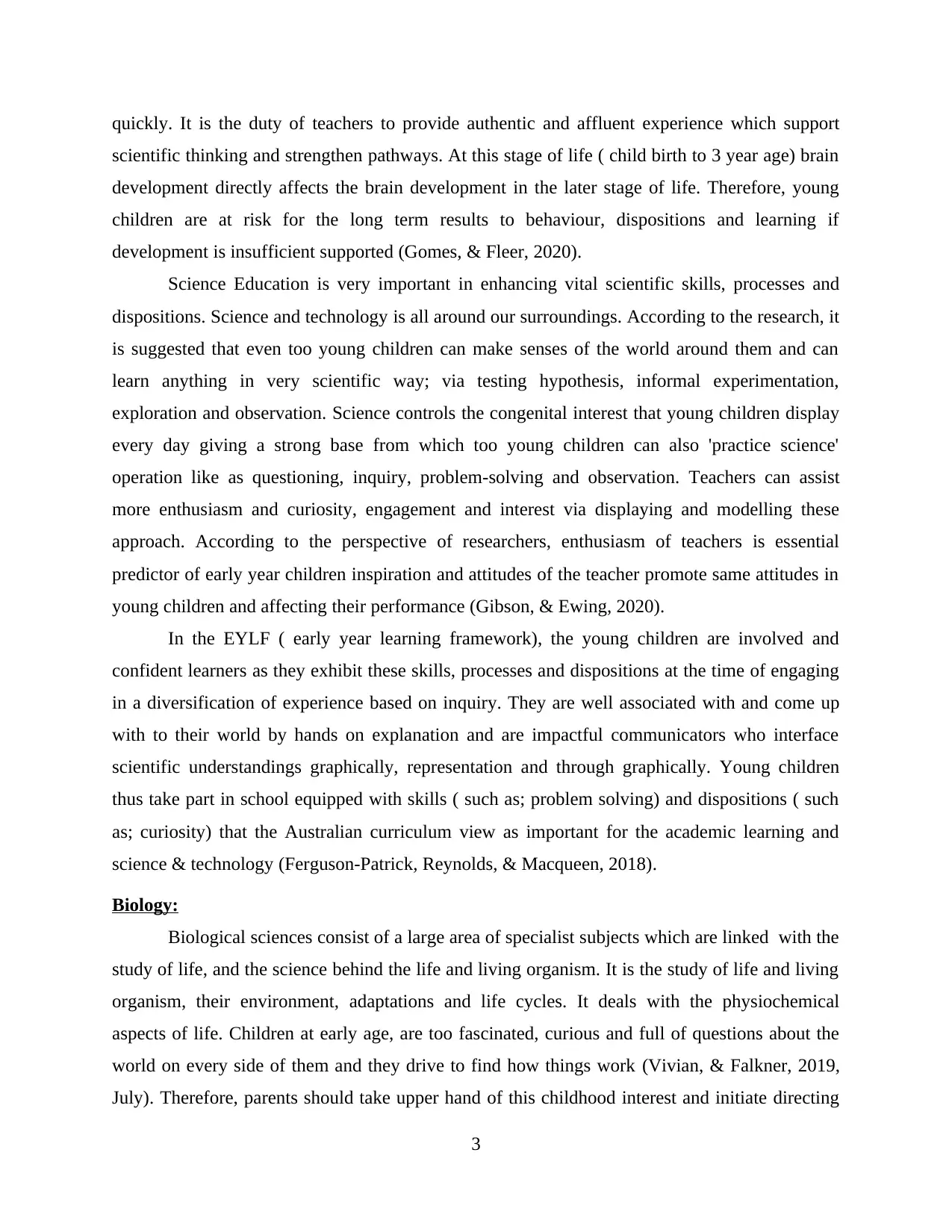
quickly. It is the duty of teachers to provide authentic and affluent experience which support
scientific thinking and strengthen pathways. At this stage of life ( child birth to 3 year age) brain
development directly affects the brain development in the later stage of life. Therefore, young
children are at risk for the long term results to behaviour, dispositions and learning if
development is insufficient supported (Gomes, & Fleer, 2020).
Science Education is very important in enhancing vital scientific skills, processes and
dispositions. Science and technology is all around our surroundings. According to the research, it
is suggested that even too young children can make senses of the world around them and can
learn anything in very scientific way; via testing hypothesis, informal experimentation,
exploration and observation. Science controls the congenital interest that young children display
every day giving a strong base from which too young children can also 'practice science'
operation like as questioning, inquiry, problem-solving and observation. Teachers can assist
more enthusiasm and curiosity, engagement and interest via displaying and modelling these
approach. According to the perspective of researchers, enthusiasm of teachers is essential
predictor of early year children inspiration and attitudes of the teacher promote same attitudes in
young children and affecting their performance (Gibson, & Ewing, 2020).
In the EYLF ( early year learning framework), the young children are involved and
confident learners as they exhibit these skills, processes and dispositions at the time of engaging
in a diversification of experience based on inquiry. They are well associated with and come up
with to their world by hands on explanation and are impactful communicators who interface
scientific understandings graphically, representation and through graphically. Young children
thus take part in school equipped with skills ( such as; problem solving) and dispositions ( such
as; curiosity) that the Australian curriculum view as important for the academic learning and
science & technology (Ferguson-Patrick, Reynolds, & Macqueen, 2018).
Biology:
Biological sciences consist of a large area of specialist subjects which are linked with the
study of life, and the science behind the life and living organism. It is the study of life and living
organism, their environment, adaptations and life cycles. It deals with the physiochemical
aspects of life. Children at early age, are too fascinated, curious and full of questions about the
world on every side of them and they drive to find how things work (Vivian, & Falkner, 2019,
July). Therefore, parents should take upper hand of this childhood interest and initiate directing
3
scientific thinking and strengthen pathways. At this stage of life ( child birth to 3 year age) brain
development directly affects the brain development in the later stage of life. Therefore, young
children are at risk for the long term results to behaviour, dispositions and learning if
development is insufficient supported (Gomes, & Fleer, 2020).
Science Education is very important in enhancing vital scientific skills, processes and
dispositions. Science and technology is all around our surroundings. According to the research, it
is suggested that even too young children can make senses of the world around them and can
learn anything in very scientific way; via testing hypothesis, informal experimentation,
exploration and observation. Science controls the congenital interest that young children display
every day giving a strong base from which too young children can also 'practice science'
operation like as questioning, inquiry, problem-solving and observation. Teachers can assist
more enthusiasm and curiosity, engagement and interest via displaying and modelling these
approach. According to the perspective of researchers, enthusiasm of teachers is essential
predictor of early year children inspiration and attitudes of the teacher promote same attitudes in
young children and affecting their performance (Gibson, & Ewing, 2020).
In the EYLF ( early year learning framework), the young children are involved and
confident learners as they exhibit these skills, processes and dispositions at the time of engaging
in a diversification of experience based on inquiry. They are well associated with and come up
with to their world by hands on explanation and are impactful communicators who interface
scientific understandings graphically, representation and through graphically. Young children
thus take part in school equipped with skills ( such as; problem solving) and dispositions ( such
as; curiosity) that the Australian curriculum view as important for the academic learning and
science & technology (Ferguson-Patrick, Reynolds, & Macqueen, 2018).
Biology:
Biological sciences consist of a large area of specialist subjects which are linked with the
study of life, and the science behind the life and living organism. It is the study of life and living
organism, their environment, adaptations and life cycles. It deals with the physiochemical
aspects of life. Children at early age, are too fascinated, curious and full of questions about the
world on every side of them and they drive to find how things work (Vivian, & Falkner, 2019,
July). Therefore, parents should take upper hand of this childhood interest and initiate directing
3
⊘ This is a preview!⊘
Do you want full access?
Subscribe today to unlock all pages.

Trusted by 1+ million students worldwide
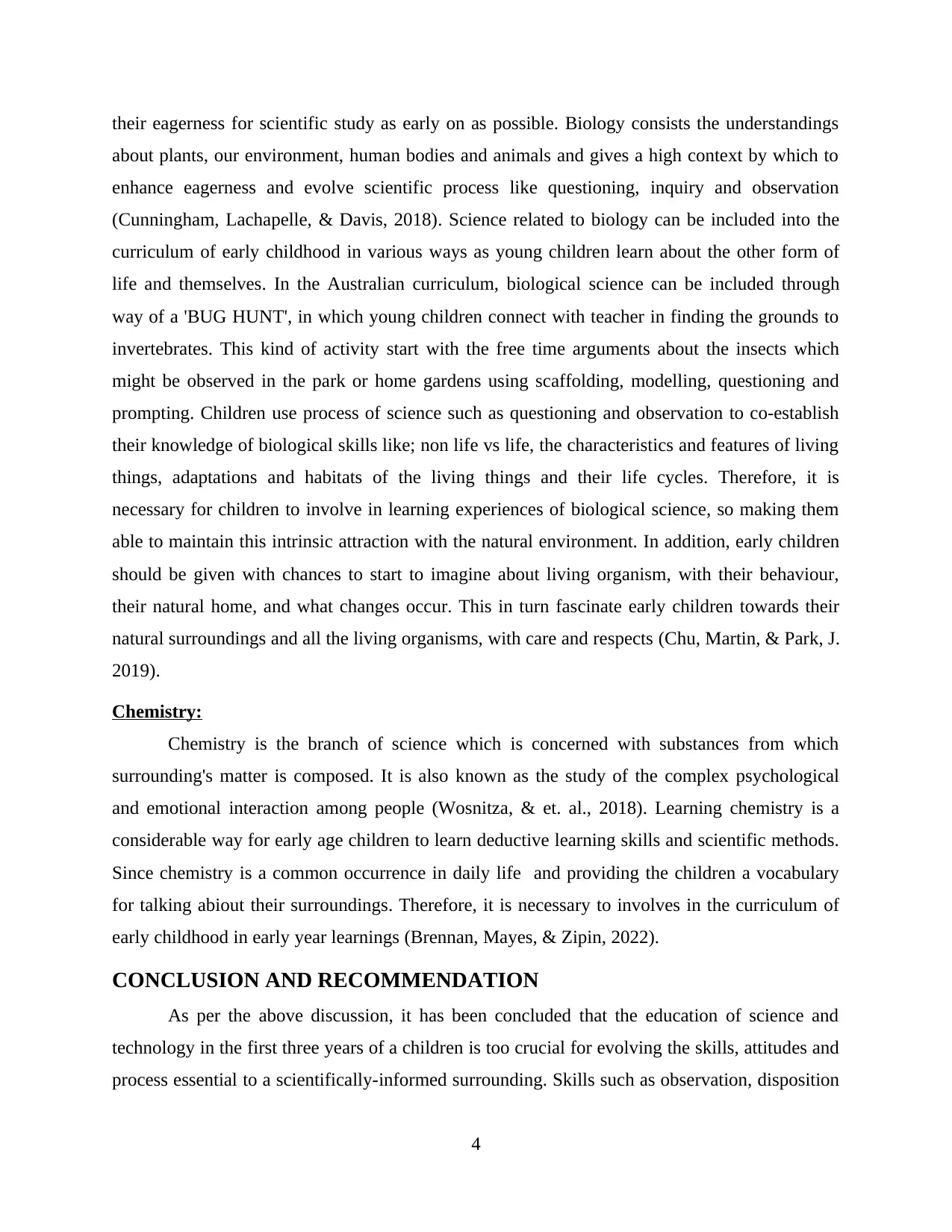
their eagerness for scientific study as early on as possible. Biology consists the understandings
about plants, our environment, human bodies and animals and gives a high context by which to
enhance eagerness and evolve scientific process like questioning, inquiry and observation
(Cunningham, Lachapelle, & Davis, 2018). Science related to biology can be included into the
curriculum of early childhood in various ways as young children learn about the other form of
life and themselves. In the Australian curriculum, biological science can be included through
way of a 'BUG HUNT', in which young children connect with teacher in finding the grounds to
invertebrates. This kind of activity start with the free time arguments about the insects which
might be observed in the park or home gardens using scaffolding, modelling, questioning and
prompting. Children use process of science such as questioning and observation to co-establish
their knowledge of biological skills like; non life vs life, the characteristics and features of living
things, adaptations and habitats of the living things and their life cycles. Therefore, it is
necessary for children to involve in learning experiences of biological science, so making them
able to maintain this intrinsic attraction with the natural environment. In addition, early children
should be given with chances to start to imagine about living organism, with their behaviour,
their natural home, and what changes occur. This in turn fascinate early children towards their
natural surroundings and all the living organisms, with care and respects (Chu, Martin, & Park, J.
2019).
Chemistry:
Chemistry is the branch of science which is concerned with substances from which
surrounding's matter is composed. It is also known as the study of the complex psychological
and emotional interaction among people (Wosnitza, & et. al., 2018). Learning chemistry is a
considerable way for early age children to learn deductive learning skills and scientific methods.
Since chemistry is a common occurrence in daily life and providing the children a vocabulary
for talking abiout their surroundings. Therefore, it is necessary to involves in the curriculum of
early childhood in early year learnings (Brennan, Mayes, & Zipin, 2022).
CONCLUSION AND RECOMMENDATION
As per the above discussion, it has been concluded that the education of science and
technology in the first three years of a children is too crucial for evolving the skills, attitudes and
process essential to a scientifically-informed surrounding. Skills such as observation, disposition
4
about plants, our environment, human bodies and animals and gives a high context by which to
enhance eagerness and evolve scientific process like questioning, inquiry and observation
(Cunningham, Lachapelle, & Davis, 2018). Science related to biology can be included into the
curriculum of early childhood in various ways as young children learn about the other form of
life and themselves. In the Australian curriculum, biological science can be included through
way of a 'BUG HUNT', in which young children connect with teacher in finding the grounds to
invertebrates. This kind of activity start with the free time arguments about the insects which
might be observed in the park or home gardens using scaffolding, modelling, questioning and
prompting. Children use process of science such as questioning and observation to co-establish
their knowledge of biological skills like; non life vs life, the characteristics and features of living
things, adaptations and habitats of the living things and their life cycles. Therefore, it is
necessary for children to involve in learning experiences of biological science, so making them
able to maintain this intrinsic attraction with the natural environment. In addition, early children
should be given with chances to start to imagine about living organism, with their behaviour,
their natural home, and what changes occur. This in turn fascinate early children towards their
natural surroundings and all the living organisms, with care and respects (Chu, Martin, & Park, J.
2019).
Chemistry:
Chemistry is the branch of science which is concerned with substances from which
surrounding's matter is composed. It is also known as the study of the complex psychological
and emotional interaction among people (Wosnitza, & et. al., 2018). Learning chemistry is a
considerable way for early age children to learn deductive learning skills and scientific methods.
Since chemistry is a common occurrence in daily life and providing the children a vocabulary
for talking abiout their surroundings. Therefore, it is necessary to involves in the curriculum of
early childhood in early year learnings (Brennan, Mayes, & Zipin, 2022).
CONCLUSION AND RECOMMENDATION
As per the above discussion, it has been concluded that the education of science and
technology in the first three years of a children is too crucial for evolving the skills, attitudes and
process essential to a scientifically-informed surrounding. Skills such as observation, disposition
4
Paraphrase This Document
Need a fresh take? Get an instant paraphrase of this document with our AI Paraphraser
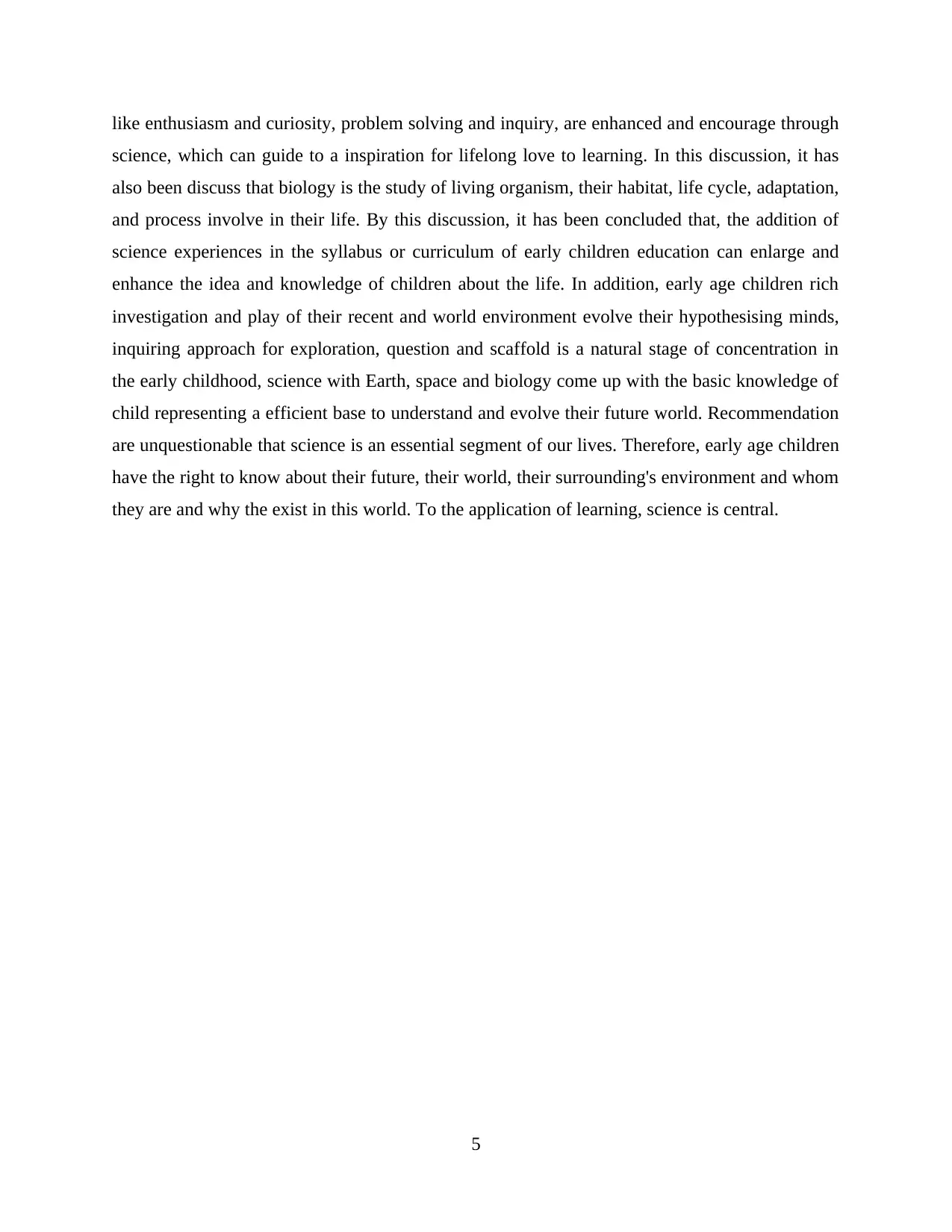
like enthusiasm and curiosity, problem solving and inquiry, are enhanced and encourage through
science, which can guide to a inspiration for lifelong love to learning. In this discussion, it has
also been discuss that biology is the study of living organism, their habitat, life cycle, adaptation,
and process involve in their life. By this discussion, it has been concluded that, the addition of
science experiences in the syllabus or curriculum of early children education can enlarge and
enhance the idea and knowledge of children about the life. In addition, early age children rich
investigation and play of their recent and world environment evolve their hypothesising minds,
inquiring approach for exploration, question and scaffold is a natural stage of concentration in
the early childhood, science with Earth, space and biology come up with the basic knowledge of
child representing a efficient base to understand and evolve their future world. Recommendation
are unquestionable that science is an essential segment of our lives. Therefore, early age children
have the right to know about their future, their world, their surrounding's environment and whom
they are and why the exist in this world. To the application of learning, science is central.
5
science, which can guide to a inspiration for lifelong love to learning. In this discussion, it has
also been discuss that biology is the study of living organism, their habitat, life cycle, adaptation,
and process involve in their life. By this discussion, it has been concluded that, the addition of
science experiences in the syllabus or curriculum of early children education can enlarge and
enhance the idea and knowledge of children about the life. In addition, early age children rich
investigation and play of their recent and world environment evolve their hypothesising minds,
inquiring approach for exploration, question and scaffold is a natural stage of concentration in
the early childhood, science with Earth, space and biology come up with the basic knowledge of
child representing a efficient base to understand and evolve their future world. Recommendation
are unquestionable that science is an essential segment of our lives. Therefore, early age children
have the right to know about their future, their world, their surrounding's environment and whom
they are and why the exist in this world. To the application of learning, science is central.
5

6
⊘ This is a preview!⊘
Do you want full access?
Subscribe today to unlock all pages.

Trusted by 1+ million students worldwide
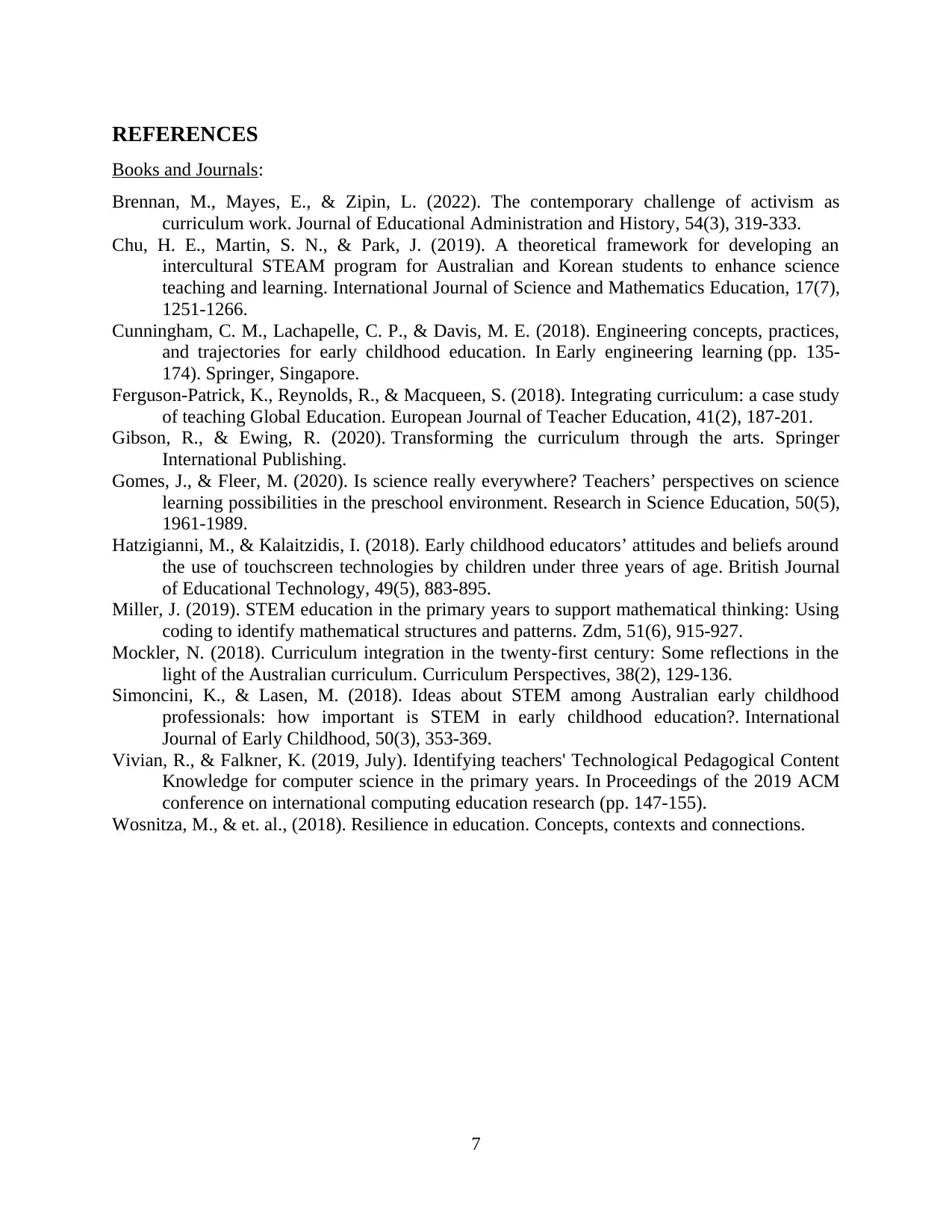
REFERENCES
Books and Journals:
Brennan, M., Mayes, E., & Zipin, L. (2022). The contemporary challenge of activism as
curriculum work. Journal of Educational Administration and History, 54(3), 319-333.
Chu, H. E., Martin, S. N., & Park, J. (2019). A theoretical framework for developing an
intercultural STEAM program for Australian and Korean students to enhance science
teaching and learning. International Journal of Science and Mathematics Education, 17(7),
1251-1266.
Cunningham, C. M., Lachapelle, C. P., & Davis, M. E. (2018). Engineering concepts, practices,
and trajectories for early childhood education. In Early engineering learning (pp. 135-
174). Springer, Singapore.
Ferguson-Patrick, K., Reynolds, R., & Macqueen, S. (2018). Integrating curriculum: a case study
of teaching Global Education. European Journal of Teacher Education, 41(2), 187-201.
Gibson, R., & Ewing, R. (2020). Transforming the curriculum through the arts. Springer
International Publishing.
Gomes, J., & Fleer, M. (2020). Is science really everywhere? Teachers’ perspectives on science
learning possibilities in the preschool environment. Research in Science Education, 50(5),
1961-1989.
Hatzigianni, M., & Kalaitzidis, I. (2018). Early childhood educators’ attitudes and beliefs around
the use of touchscreen technologies by children under three years of age. British Journal
of Educational Technology, 49(5), 883-895.
Miller, J. (2019). STEM education in the primary years to support mathematical thinking: Using
coding to identify mathematical structures and patterns. Zdm, 51(6), 915-927.
Mockler, N. (2018). Curriculum integration in the twenty-first century: Some reflections in the
light of the Australian curriculum. Curriculum Perspectives, 38(2), 129-136.
Simoncini, K., & Lasen, M. (2018). Ideas about STEM among Australian early childhood
professionals: how important is STEM in early childhood education?. International
Journal of Early Childhood, 50(3), 353-369.
Vivian, R., & Falkner, K. (2019, July). Identifying teachers' Technological Pedagogical Content
Knowledge for computer science in the primary years. In Proceedings of the 2019 ACM
conference on international computing education research (pp. 147-155).
Wosnitza, M., & et. al., (2018). Resilience in education. Concepts, contexts and connections.
7
Books and Journals:
Brennan, M., Mayes, E., & Zipin, L. (2022). The contemporary challenge of activism as
curriculum work. Journal of Educational Administration and History, 54(3), 319-333.
Chu, H. E., Martin, S. N., & Park, J. (2019). A theoretical framework for developing an
intercultural STEAM program for Australian and Korean students to enhance science
teaching and learning. International Journal of Science and Mathematics Education, 17(7),
1251-1266.
Cunningham, C. M., Lachapelle, C. P., & Davis, M. E. (2018). Engineering concepts, practices,
and trajectories for early childhood education. In Early engineering learning (pp. 135-
174). Springer, Singapore.
Ferguson-Patrick, K., Reynolds, R., & Macqueen, S. (2018). Integrating curriculum: a case study
of teaching Global Education. European Journal of Teacher Education, 41(2), 187-201.
Gibson, R., & Ewing, R. (2020). Transforming the curriculum through the arts. Springer
International Publishing.
Gomes, J., & Fleer, M. (2020). Is science really everywhere? Teachers’ perspectives on science
learning possibilities in the preschool environment. Research in Science Education, 50(5),
1961-1989.
Hatzigianni, M., & Kalaitzidis, I. (2018). Early childhood educators’ attitudes and beliefs around
the use of touchscreen technologies by children under three years of age. British Journal
of Educational Technology, 49(5), 883-895.
Miller, J. (2019). STEM education in the primary years to support mathematical thinking: Using
coding to identify mathematical structures and patterns. Zdm, 51(6), 915-927.
Mockler, N. (2018). Curriculum integration in the twenty-first century: Some reflections in the
light of the Australian curriculum. Curriculum Perspectives, 38(2), 129-136.
Simoncini, K., & Lasen, M. (2018). Ideas about STEM among Australian early childhood
professionals: how important is STEM in early childhood education?. International
Journal of Early Childhood, 50(3), 353-369.
Vivian, R., & Falkner, K. (2019, July). Identifying teachers' Technological Pedagogical Content
Knowledge for computer science in the primary years. In Proceedings of the 2019 ACM
conference on international computing education research (pp. 147-155).
Wosnitza, M., & et. al., (2018). Resilience in education. Concepts, contexts and connections.
7
1 out of 10
Related Documents
Your All-in-One AI-Powered Toolkit for Academic Success.
+13062052269
info@desklib.com
Available 24*7 on WhatsApp / Email
![[object Object]](/_next/static/media/star-bottom.7253800d.svg)
Unlock your academic potential
Copyright © 2020–2025 A2Z Services. All Rights Reserved. Developed and managed by ZUCOL.





